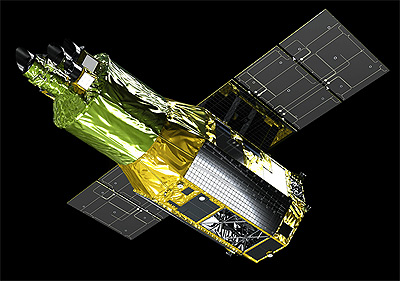Thank you very much for visiting Gunter's Space Page. I hope that this site is useful and informative for you.
If you appreciate the information provided on this site, please consider supporting my work by making a simple and secure donation via PayPal. Please help to run the website and keep everything free of charge. Thank you very much.
XRISM (XARM)

XRISM [JAXA]
The XRISM (X-ray Imaging and Spectroscopy Mission), initially known as XARM (X-ray Astronomy Recovery Mission), satellite is a Japanese X-ray observatory, which is to replace partially the lost Astro H (Hitomi) observatory.
XRISM will carry replacements for Hitomi’s two lower-energy instruments — the Soft X-ray Imager and the Soft X-ray Spectrometer. The two Hard X-ray Telescopes and imagers will not be replaced.
NASA provides a copy of Astro-H's High-Resolution Soft X-Ray Spectrometer (SXS) called Resolve, which will probe matter in extreme environments; investigate the nature of dark matter on large scales in the universe; and explore how galaxies and clusters of galaxies form and evolve.
The XRISM payload consists of two instruments:
- Resolve, a soft X-ray spectrometer, which combines a lightweight X-Ray Mirror Assembly paired with an X-ray calorimeter spectrometer, and provides non-dispersive 5-7 eV energy resolution in the 0.3-12 keV bandpass with a field of view of about 3 arcmin.
- Xtend, a soft X-ray imager, is a CCD detector that extends the field of the observatory to 38 arcmin over the energy range 0.4-13 keV, using an identical lightweight X-Ray Mirror Assembly.
Their characteristics are similar to the SXS and SXI respectively flown on Hitomi and XRISM is designed to resume with most of the science capability lost with the Hitomi mishap.
The satellite might be used in conjunction with NuSTAR, which can cover the Hard X-ray segment not included in XRISM.
In July 2017, the mission was apporoved. A launch is planned for 2021.
| Nation: | Japan |
|---|---|
| Type / Application: | Astronomy, X-Ray |
| Operator: | JAXA, NASA |
| Contractors: | |
| Equipment: | Rsolve, Xtend |
| Configuration: | |
| Propulsion: | |
| Power: | 2 deployable fixed solar arrays, batteries |
| Lifetime: | 3 years |
| Mass: | 2300 kg |
| Orbit: | 567 km × 580 km, 31.00° |
| Satellite | COSPAR | Date | LS | Launch Vehicle | Remarks | |
|---|---|---|---|---|---|---|
| XRISM (ex XARM) | 2023-137A | 06.09.2023 | Ta YLP-1 | H-2A-202 | with SLIM |
References:
Further Astro missions:
|
Further Explorer Missions of Opportunity (MoO) and International Missions (Int):
Missions of Opportunity:
|
